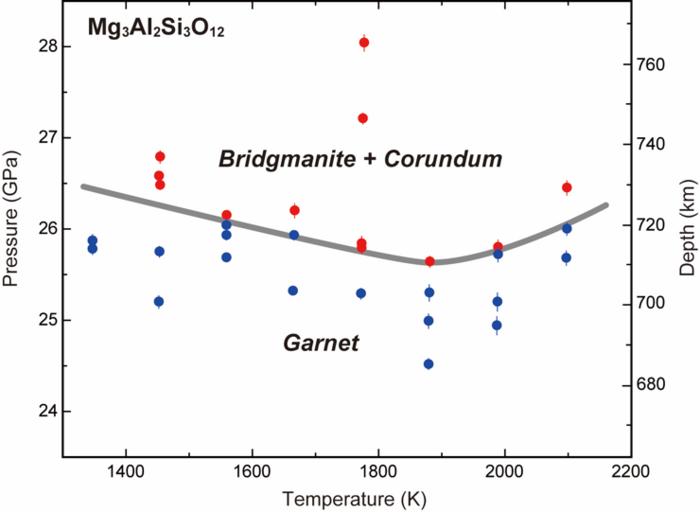An international research group led by Dr. Takayuki Ishii from HPSTAR and Okayama University, Institute for Planetary Materials, in collaboration with colleagues from Bayerisches Geoinstitut, University of Bayreuth, Germany, and Japan Synchrotron Radiation Research Institute, Okayama University Institute for Planetary Materials and Tohoku University, Japan, Peking University and Yanshan University, China has precisely determined the temperature dependence of the high-pressure phase transition pressure of a mantle mineral of pyrope garnet to bridgmanite plus corundum (post-garnet transition) which may well explain the puzzling dynamics of subducting slabs and upwelling plumes observed seismically in the upper part of the lower mantle. The results were published in Nature Geoscience.

Credit: Takayuki Ishii
An international research group led by Dr. Takayuki Ishii from HPSTAR and Okayama University, Institute for Planetary Materials, in collaboration with colleagues from Bayerisches Geoinstitut, University of Bayreuth, Germany, and Japan Synchrotron Radiation Research Institute, Okayama University Institute for Planetary Materials and Tohoku University, Japan, Peking University and Yanshan University, China has precisely determined the temperature dependence of the high-pressure phase transition pressure of a mantle mineral of pyrope garnet to bridgmanite plus corundum (post-garnet transition) which may well explain the puzzling dynamics of subducting slabs and upwelling plumes observed seismically in the upper part of the lower mantle. The results were published in Nature Geoscience.
The temperature dependence of the post-garnet transition pressure, so called Clapeyron slope, determined in this study changes from negative to positive with increasing temperature, and the slope becomes zero at the average mantle temperature. These are unique properties not found in other mantle minerals. The curved post-garnet transition decelerates subduction of cold slabs and accelerates upwelling of hot plumes. Thus, slab stagnation and plume invisibility (interpreted as thinning by plume acceleration) described above can be explained by the post-garnet transition.
Mantle convection, manifested as the subduction of cold slabs and the upwelling of hot plumes, drives near-surface processes such as volcanism and seismicity, and the chemical evolution of the Earth’s interior. Seismic tomography studies have drawn that many subducting slabs stagnate, and upwelling plumes become invisible at depths of 660–1000 km. These observations have tried to be interpreted by a viscosity increase with depth in this region. However, the reason for this viscosity change is not clear yet.
An alternative and more promising interpretation is a phase transition. The temperature dependence of the transition pressure, so called Clapeyron slope, is of great importance to control mantle convection. A negative Clapeyron slope impedes mantle convection, whereas a positive slope accelerates it. Then which mineral’s phase transition at depths of 660 to 1000 km have both negative and positive slope?
At depths between 660 km and 1000 km, a mantle mineral pyrope garnet will breakdown into bridgmanite and corundum, so called post-garnet phase transition. Will this phase boundary be responsible for the long-standing seismic puzzle?However, the slope of the post-garnet transition was determined to be almost zero from previous studies. “The phase boundary of minerals determined from traditional methods are not conclusive owing to limitations in the experimental technique: limited pressure resolution and potential misinterpretation of the stable phase,” explained Dr. Ishii. “For this reason, we have developed a new approach that can accurately determine phase stability with much improved pressure resolution.”
Using this technique, they have determined the post-garnet phase boundary at a wide range of temperatures from subducting cold slabs to upwelling hot plumes. They found that the post-garnet phase boundary is located at a depth of ~720 km, with a downward-convex shape: the slope changes from negative to positive with increasing temperature, and becomes zero around the ambient mantle temperature (Fig. 1). The curved nature of the boundary breaks the stereotype of a phase boundary having only either a positive slope or a negative slope. Its negative slope at low temperatures produces upward buoyancy in cold regions. In contrast, its positive slope at higher temperatures produces upward buoyancy in hot regions.
The curved post-garnet phase boundary could explain seismological observations in the upper part of the lower mantle (Fig. 2). Subducting slabs can stagnate between depths of 660–1000 km because there is upward buoyancy arising from the negative slope of the phase transition. Slab subduction will restart when the slab loses buoyancy due to warming by the surrounding mantle. Upward buoyancy in hot regions produced by the positive slope could accelerate upwelling plumes, thinning and making them tomographically invisible at 660–1000 km deep.
More information: Ishii, T., Frost, D.J., Kim, E.J. et al. Buoyancy of slabs and plumes enhanced by curved post-garnet phase boundary. Nat. Geosci. (2023). https://doi.org/10.1038/s41561-023-01244-w.
Journal
Nature Geoscience
DOI
10.1038/s41561-023-01244-w
Method of Research
Experimental study
Article Publication Date
27-Jul-2023




